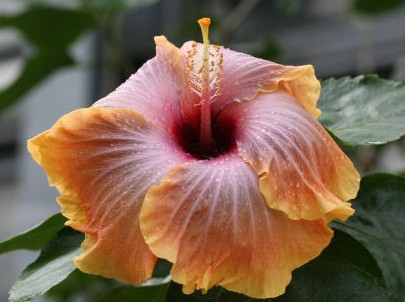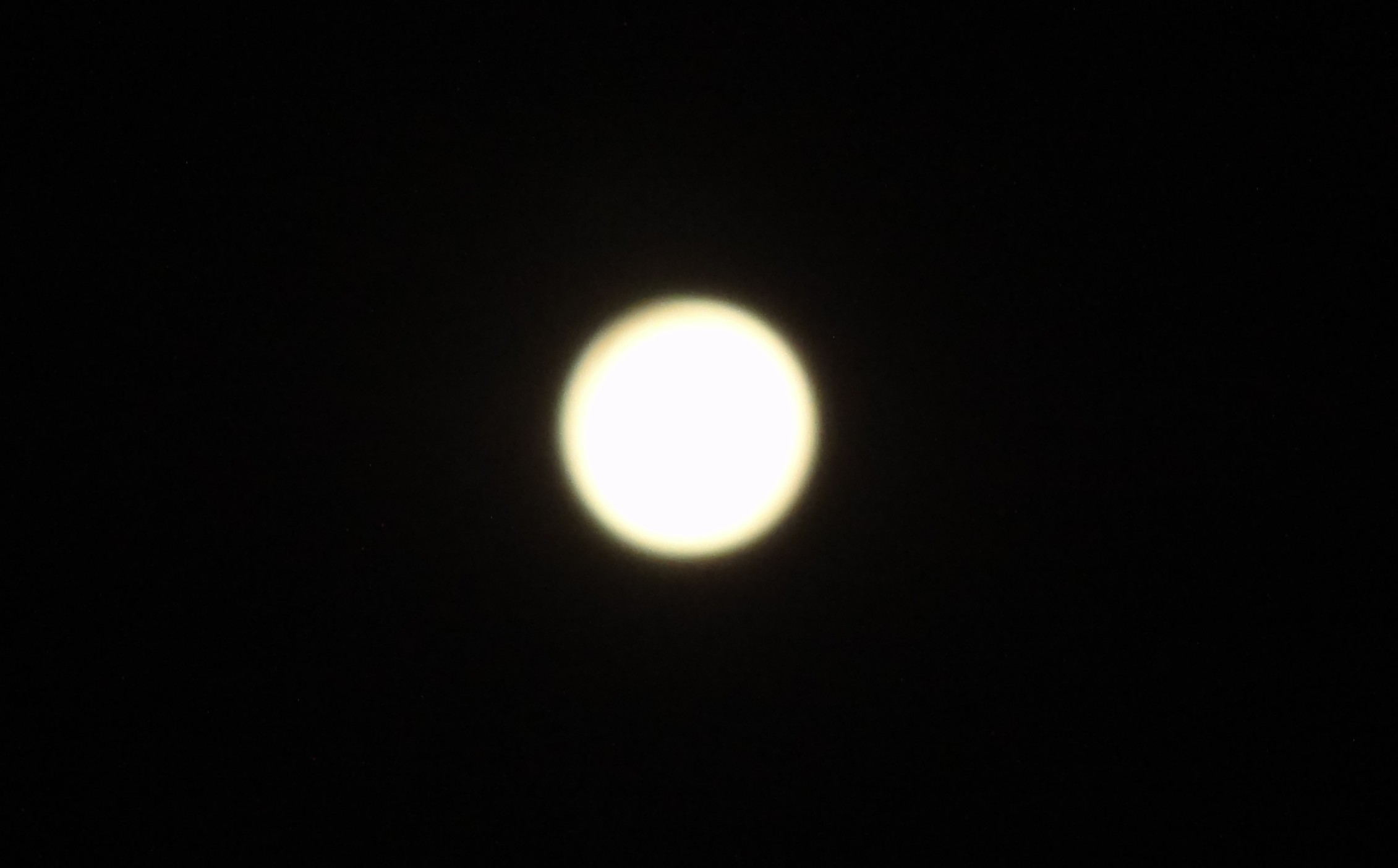Good morning!
When I came here I saw the big brilliant sun already up in the sky. The moon is almost full now. With warmer weather we have a lot of flowers and abundant greenery around us.
An NHK program “Science Zero” from Japan talked about the recent golden ring solar eclipse having taken place more than nine centuries after the previous one. The distance from the earth and the size of the sun are four hundred times greater than those of the moon from the earth and in comparison with the moon. That is why we see the golden solar ring or total solar eclipse, depending on the distance between the moon and the earth, either the farthest side of 400,000km or the closest side of 360,000km in the oblong orbit of the moon. Because the high tide of the earth caused by the gravity between the moon and earth is going ahead of the moon’s orbital movement due to the earth’s quicker spin motion relative to the moon, the distance between the two is increasing 3.8cm yearly. As the moon moves farther away, our future generations will not be able to see the total solar eclipse, but only the solar ring eclipse. Seen from space, the shadow of the moon is moving on the earth. Those in the central shadow area can see the golden ring, those at the shadow border area can see the partial eclipse, but those outside the shadow see no solar eclipse.
We now can see morning glories around our vegetable garden in the back and along the front hedge. We can see day lilies almost everywhere in our yard. And now the hibiscus have started to bloom. It blooms for three seasons here, but year round in Okinawa. Thus, it is called endlessly blooming flower, mugonka (無限花), and is the Okinawa Island flower, Hawaiian state flower, and the Korean national flower. It is called mukuge (槿), undefiled flower (無垢華). It is also called bussoge (佛桑華), Buddha’s purity flower or Buddha nature flower. When we enter the MZC at the front door, we see only the flowers in the front yard. When we come in using the back door, we see the flowers in the back yard. When we work, watering or weeding, we find pretty tiny flowers blooming or peeping out. The seemingly dead bougainvillea sprouted and is growing now. Yesterday I found a seemingly live tree dead due to a vine climbing and choking it.
Trees look rather simple from the outside, but they are rooted deeply into the earth and stand high into the sky, working with the moon, the sun, stars, birds, bees, giving us oxygen, flowers, fruit, shade and shelter. They don’t have eyes, ears, nose, etc. like us, but they see the sun, hear other trees, sense touch, gravity, etc. We can’t see how they function inside, but they function with genes, cells, tissues, organs, constantly working with the whole universe. That is why they can survive thousands of years. What we see is only the tip of a huge iceberg under the sea. Astronomers say the visible world is only several per cent of the universe, the rest being dark matter and the world.
The way planets move and plants live tells us about our practice. How do plants, especially trees, live? Trees sometimes survive ten thousand years. Due to their long enduring characters, tree and true share the same root, perhaps dhree, the root of dharma, norm of all forms, dependent origination.
Sesshin is embracing the mind (摂心) and touching the mind (接心). How can we do so? Zen (Japanese), chan (Chinese), jhâna (Pali), dhyâna (Sanskrit) is usually translated as meditation. We may think we use concepts or images, etc. in meditation. The Sino-Japanese translation of it, however, is meiso (瞑想), dark thought or thinking in darkness, which means deep, profound prognosis. Only when we retreat from the visible tip of the iceberg and settle into this huge mass of profundity, can we witness the vast area under the sea in the deep dark world. Then we start seeing how our karma world with our eyes, ears, nose, tongue, body, and mind, etc. is limited, and we sense the necessity of looking into the deep, the Buddha mind, the full moon mind. The Buddha knew how to embrace the mind and touch the mind. When we sit, we stop almost all karmas except some fundamental functions like heart beat and breathing, which go on beyond our conceptions or intentions.
Buddhism talks about eight or nine consciousnesses – frontal five consciousnesses (through eyes, ears, nose, tongue, and body), manas (mind), mental consciousness and store-consciousness. The eighth is called âlaya–vijñâna/viññâna, like hima-âlaya, snow-stored (mountain). This sitting is really seeing, cultivating, and transforming our minds. It is said that the store-consciousness is transformed into the mirror-consciousness, the mental/self consciousness into equality consciousness, the mind into subtlety observing consciousness, and the five front consciousnesses into duty fulfilling consciousnesses. So, our actions become settled, straightened sîla, pillar. When we sit straight, we become like solid pillars or great old trees established on truth. Samâdhi is usually translated as concentration, but literally it is sam (total) adhi (transcendent) i (going), transcending all and unifying all, in deep, profound prognosis, beyond the visible world discriminating between self and other, here and there, etc. Then, we understand the one world beyond superficial distinctions and discriminations, like Avalokitesvara, On-looker, (with profound prognosis and compassion) Bodhisattva, penetrating non-substantiality of self-nature, matter, etc., witnessing no eyes, ears, nose, tongue, body, etc., and no old age, no death, etc.
Yesterday, I read an article titled “The One percent’s problems” by Stiglitze, illustrating that the Walton (Walmart heirs) family’s assets of some 90 billion dollars is equivalent to wealth of the bottom 30% of Americans, and saying they must solve their problems with all not only for others, but for themselves also. They only see the visible matter and power or money, called civilization, urbanization, the pyramidal system, which creates class systems, wars, global warming, mass extinction, etc. Because we are caught by the tip of the iceberg and act accordingly, we damage the true life system, the integral unified system. So, we need to really come back and settle in the invisible world of mind and life in true cultivation and culture. We must find out what mind is and what life is, and find true harmony, happiness, and holiness. Only in this way can we become holy (wholly wholesome) like king Mirror, Âdassa, enjoying unconditioned peace, unsurpassed awakening and amrita, ambrosia of immortality, rather than the summoned blind people feeling an animal but finding only a part of the whole, and fighting for their partial perspective.
Anyone can realize these things anywhere, any time, together with all. Without this we are doomed to destruction and demise. So, we must practice sitting, stopping karma, seeing truth together with all. How we can realize these things with all is the real question and our true task.
6/3/12
Note: Hibiscus is called mukuge (槿), mokuge (木槿), bussôge (仏桑華), hachisu (蓮, lotus), asagao (朝顔: morning glory, lit. morning face, blooming only in the morning and daytime, either blooming one day only like morning glories or many days). From these names, it seems to be compared to lotus flower (in tree form, cf. mokuren: 木蓮:tree lotus) (or Buddha’s figure of the pistil, looking like the Avalokitesvara Bodhisattva with a thousand helping hands on the lotus pedals: see the photo below).
The full moon of June 4, 2012 C.E.


